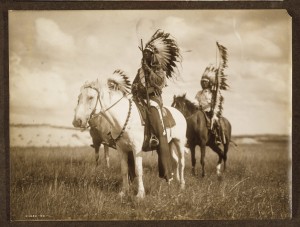Photographs offer a snapshot of a particular time and place, telling a careful viewer as much about the photographer as about the subjects of the pictures. That’s often particularly true when the photographer isn’t a member of the group being photographed.
One example from the Library of Congress’s collections is Edward S. Curtis, who dedicated most of his career to photographing Native American cultures and traditions to publish in a multi-volume book titled The North American Indian.
A close observation and study of even a randomly selected set of images will show that Curtis was photographing for a particular effect and purpose. The collection background indicates that ‘he believed that indigenous communities would inevitably be absorbed into white society, losing their unique cultural identities. He wanted to create a scholarly and artistic work that would document the ceremonies, beliefs, customs, daily life, and leaders of these groups before they “vanished.”’
Some critics suggest that he manipulated the images, cropping tourists or indicators of modern life out of his photos because that didn’t fit his perspective on Native Americans. In The Myth of the Vanishing Race, David R.M. Beck situates Curtis’s work as part of a general “nostalgia for an ‘almost extinct civilization’” that included artificially constructed events like Wild West shows and an Indian village at the 1893 Columbian World’s Exposition.
Students can select 8-10 photographs and study them for evidence or examples:
- …of techniques that Curtis used. Are there props? How often does he take a close up? How often does he include background or use a long view? What is the effect of the choices?
- …to support or refute Beck’s claim that Curtis’s work reflects nostalgia for an “almost extinct civilization.” They might respond in writing or by participating in a discussion or a debate.
- …of what was important to the people being photographed.
Additional resources from the Library of Congress:
To find sample images, search on Dancer, Ceremony, Chief, Warrior, House, Priest
The essay Edward S. Curtis in Context includes background on Curtis’s work The North American Indian.
Edward S. Curtis’s The North American Indian: Photographic Images Collection Connection offers historical context and teaching ideas.
In the comments, please let us know what your students see in these images.



November 9, 2012 at 12:33 pm
I like the idea of providing groups of Edward S. Curtis photographs for students to analyze. The links to sample images are particularly helpful, and they show the power of keyword searching within a collection. Each small group of students could work on a different cultural concept that way. Thanks for the ideas!